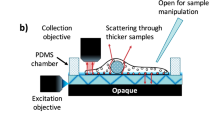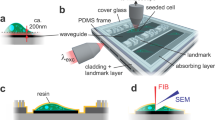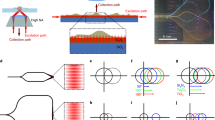Abstract
Present optical nanoscopy techniques use a complex microscope for imaging and a simple glass slide to hold the sample. Here, we demonstrate the inverse: the use of a complex, but mass-producible optical chip, which hosts the sample and provides a waveguide for the illumination source, and a standard low-cost microscope to acquire super-resolved images via two different approaches. Waveguides composed of a material with high refractive-index contrast provide a strong evanescent field that is used for single-molecule switching and fluorescence excitation, thus enabling chip-based single-molecule localization microscopy. Additionally, multimode interference patterns induce spatial fluorescence intensity variations that enable fluctuation-based super-resolution imaging. As chip-based nanoscopy separates the illumination and detection light paths, total-internal-reflection fluorescence excitation is possible over a large field of view, with up to 0.5 mm × 0.5 mm being demonstrated. Using multicolour chip-based nanoscopy, we visualize fenestrations in liver sinusoidal endothelial cells.
This is a preview of subscription content, access via your institution
Access options
Access Nature and 54 other Nature Portfolio journals
Get Nature+, our best-value online-access subscription
$29.99 / 30 days
cancel any time
Subscribe to this journal
Receive 12 print issues and online access
$209.00 per year
only $17.42 per issue
Buy this article
- Purchase on Springer Link
- Instant access to full article PDF
Prices may be subject to local taxes which are calculated during checkout





Similar content being viewed by others
References
Schermelleh, L., Heintzmann, R. & Leonhardt, H. A guide to super-resolution fluorescence microscopy. J. Cell Biol. 190, 165–175 (2010).
Gustafsson, M. G. Surpassing the lateral resolution limit by a factor of two using structured illumination microscopy. J. Microsc. 198, 82–87 (2000).
Heintzmann, R. & Cremer, C. G. Laterally modulated excitation microscopy: improvement of resolution by using a diffraction grating. Proc. SPIE 3568, 185–196 (1999).
Hell, S. W. & Wichmann, J. Breaking the diffraction resolution limit by stimulated emission: stimulated-emission-depletion fluorescence microscopy. Opt. Lett. 19, 780–782 (1994).
Willig, K. I., Rizzoli, S. O., Westphal, V ., Jahn, R. & Hell, S. W. STED microscopy reveals that synaptotagmin remains clustered after synaptic vesicle exocytosis. Nature 440, 935–939 (2006).
Dertinger, T., Colyer, R., Iyer, G., Weiss, S. & Enderlein, J. Fast, background-free, 3D super-resolution optical fluctuation imaging (SOFI). Proc. Natl Acad. Sci. USA 106, 22287–22292 (2009).
Yahiatène, I., Hennig, S., Müller, M. & Huser, T. Entropy-based super-resolution imaging (ESI): from disorder to fine detail. ACS Photon. 2, 1049–1056 (2015).
Rust, M. J., Bates, M. & Zhuang, X. Stochastic optical reconstruction microscopy (STORM) provides sub-diffraction-limit image resolution. Nat. Methods 3, 793–795 (2006).
Heilemann, M. et al. Subdiffraction-resolution fluorescence imaging with conventional fluorescent probes. Angew. Chem. Int. Ed. 47, 6172–6176 (2008).
Betzig, E. et al. Imaging intracellular fluorescent proteins at nanometer resolution. Science 313, 1642–1645 (2006).
Hess, S. T., Girirajan, T. P. K. & Mason, M. D. Ultra-high resolution imaging by fluorescence photoactivation localization microscopy. Biophys. J. 91, 4258–4272 (2006).
Hoyer, P., Staudt, T., Engelhardt, J. & Hell, S. W. Quantum dot blueing and blinking enables fluorescent microscopy. Nano Lett. 11, 245–250 (2010).
Xu, J. Q., Tehrani, K. F. & Kner, P. Multicolor 3D super-resolution imaging by quantum dot stochastic optical reconstruction microscopy. ACS Nano 9, 2917–2925 (2015).
Tokunaga, M., Imamoto, N. & Sakata-Sogawa, K . Highly inclined thin illumination enables clear single-molecule imaging in cells. Nat. Methods 5, 159–161 (2007).
Planchon, T. A. et al. Rapid three-dimensional isotropic imaging of living cells using Bessel beam plane illumination. Nat. Methods 8, 417–423 (2011).
Chen, B. C. et al. Lattice light-sheet microscopy: imaging molecules to embryos at high spatiotemporal resolution. Science 346, 1257998 (2014).
Grandin, H. M., Stadler, B., Textor, M. & Voros, J. Waveguide excitation fluorescence microscopy: a new tool for sensing and imaging the biointerface. Biosens. Bioelectron. 21, 1476–1482 (2006).
Agnarsson, B., Ingthorsson, S., Gudjonsson, T. & Leosson, K. Evanescent-wave fluorescence microscopy using symmetric planar waveguides. Opt. Express 17, 5075–5082 (2009).
Agnarsson, B., Jonsdottir, A. B., Arnfinnsdottir, N. B. & Leosson, K. On-chip modulation of evanescent illumination and live-cell imaging with polymer waveguides. Opt. Express 19, 22929–22935 (2011).
Shen, H. et al. TIRF microscopy with ultra-short penetration depth. Opt. Express 22, 10728–10734 (2014).
Agnarsson, B. et al. Evanescent light-scattering microscopy for label-free interfacial imaging: from single sub-100 nm vesicles to live cells. ACS Nano 9, 11849–11862 (2015).
Ramachandran, S., Cohen, D. A., Quist, A. P. & Lal, R. High performance, LED powered, waveguide based total internal reflection microscopy. Sci. Rep. 3, 2133 (2013).
Dhakal, A. et al. Evanescent excitation and collection of spontaneous Raman spectra using silicon nitride nanophotonic waveguides. Opt. Lett. 39, 4025–4028 (2014).
Fedyanin, D. Y. & Stebunov, Y. V. All-nanophotonic NEMS biosensor on a chip. Sci. Rep. 5, 10968 (2015).
Yurtsever, G. et al. Photonic integrated Mach–Zehnder interferometer with an on-chip reference arm for optical coherence tomography. Biomed. Opt. Express 5, 1050–1061 (2014).
Sørensen, K. K., Simon-Santamaria, J., McCuskey, R. S. & Smedsrød, B. Liver sinusoidal endothelial cells. Compr. Physiol. 5, 1751–1574 (2015).
Weber, K., Rathke, P. C. & Osborn, M. Cytoplasmic microtubular images in glutaraldehyde-fixed tissue culture cells by electron microscopy and by immunofluorescence microscopy. Proc. Natl Acad. Sci. USA 75, 1820–1824 (1978).
Olivier, N., Keller, D., Gonczy, P. & Manley, S. Resolution doubling in 3D-STORM imaging through improved buffers. PLoS ONE 8, e69004 (2013).
Vaughan, J. C., Jia, S. & Zhuang, X. Ultra-bright photoactivatable fluorophores created by reductive caging. Nat. Methods 9, 1181–1184 (2012).
Endesfelder, U. & Heilemann, M. Art and artifacts in single-molecule localization microscopy: beyond attractive images. Nat. Methods 11, 235–238 (2014).
Bourg, N. et al. Direct optical nanoscopy with axially localized detection. Nat. Photon. 9, 587–593 (2015).
Endesfelder, U., Malkusch, S., Fricke, F. & Heilemann, M. A simple method to estimate the average localization precision of a single-molecule localization microscopy experiment. Histochem. Cell Biol. 141, 629–638 (2014).
Nieuwenhuizen, R. P. et al. Measuring image resolution in optical nanoscopy. Nat. Methods 10, 557–562 (2013).
Banterle, N., Bui, K. H., Lemke, E. A. & Beck, M. Fourier ring correlation as a resolution criterion for super-resolution microscopy. J. Struct. Biol. 183, 363–367 (2013).
Douglass, K. M., Sieben, C., Archetti, A., Lambert, A. & Manley, S. Super-resolution imaging of multiple cells by optimised flat-field epi-illumination. Nat. Photon. 10, 705–708 (2016).
Smedsrød, B. & Pertoft, H. Preparation of pure hepatocytes and reticuloendothelial cells in high yield from a single rat liver by means of Percoll centrifugation and selective adherence. J. Leukoc. Biol. 38, 213–230 (1985).
Ahluwalia, B. S. et al. Fabrication of submicrometer high refractive index tantalum pentoxide waveguides for optical propulsion of microparticles. IEEE Photon. Technol. Lett. 21, 1408–1410 (2009).
Ventalon, C. & Mertz, J. Quasi-confocal fluorescence sectioning with dynamic speckle illumination. Opt. Lett. 30, 3350–3352 (2005).
Kim, M., Park, C., Rodriguez, C., Park, Y. & Cho, Y. H. Superresolution imaging with optical fluctuation using speckle patterns illumination. Sci. Rep. 5, 16525 (2015).
Wolter, S. et al. rapidSTORM: accurate, fast open-source software for localization microscopy. Nat. Methods 9, 1040–1041 (2012).
Smith, C. S., Joseph, N., Rieger, B. & Lidke, K. A. Fast, single-molecule localization that achieves theoretically minimum uncertainty. Nat. Methods 7, 373–375 (2010).
Cogger, V. C., Roessner, U., Warren, A., Fraser, R. & Le Couteur, D. G. A sieve-raft hypothesis for the regulation of endothelial fenestrations. Comput. Struct. Biotechnol. J. 8, e201308003 (2013).
Mönkemöller, V. et al. Imaging fenestrations in liver sinusoidal endothelial cells by optical localization microscopy. Phys. Chem. Chem. Phys. 16, 12576–12581 (2014).
Mönkemöller, V., Øie, C., Hübner, W., Huser, T. & McCourt, P. Multimodal super-resolution optical microscopy visualizes the close connection between membrane and the cytoskeleton in liver sinusoidal endothelial cell fenestrations. Sci Rep. 5, 16279 (2015).
Braet, F. & Wisse, E. Structural and functional aspects of liver sinusoidal endothelial cell fenestrae: a review. Comp. Hepatol. 1, 1 (2002).
Wang, X. et al. Enhanced cell sorting and manipulation with combined optical tweezer and microfluidic chip technologies. Lab Chip 11, 3656–3662 (2011).
Helle, Ø. I., Ahluwalia, B. S. & Hellesø, O. G. Optical transport, lifting and trapping of micro-particles by planar waveguides. Opt. Express 23, 6601–6612 (2015).
Dullo, F. T. & Hellesø, O. G. On-chip phase measurement for microparticles trapped on a waveguide. Lab Chip 15, 3918–3924 (2015).
Jain, A. et al. Probing cellular protein complexes using single-molecule pull-down. Nature 473, 484–488 (2011).
Diekmann, R. et al. Nanoscopy of bacterial cells immobilized by holographic optical tweezers. Nat. Commun. 7, 13711 (2016).
Prieto, F. et al. An integrated optical interferometric nanodevice based on silicon technology for biosensor applications. Nanotechnology 14, 907–912 (2003).
van de Linde, S. et al. Direct stochastic optical reconstruction microscopy with standard fluorescent probes. Nat. Protoc. 6, 991–1009 (2011).
Schindelin, J. et al. Fiji: an open-source platform for biological-image analysis. Nat. Methods 9, 676–682 (2012).
Ovesny, M., Krizek, P., Borkovec, J., Svindrych, Z. & Hagen, G. M. ThunderSTORM: a comprehensive ImageJ plug-in for PALM and STORM data analysis and super-resolution imaging. Bioinformatics 30, 2389–2390 (2014).
Acknowledgements
The authors thank I. Yahiatène and M. Müller for help with the ESI reconstruction algorithm and V. Mönkemöller for help with sample preparation and membrane dye staining. This work was supported by the European Research Council (grant no. 336716 to B.S.A.), the Research Council of Norway (grant no. 244764/F11 to B.S.A.) and the German Academic Exchange Service (grant no. 57160327 to M.S.). R.D. acknowledges additional support from grant no. KF2140610NT4 of the German Federal Ministry for Economic Affairs and Energy.
Author information
Authors and Affiliations
Contributions
B.S.A. and M.S. conceived the project. All authors designed the research. C.I.Ø. isolated the cells and stained and prepared the biological samples. R.D. and Ø.I.H. built the set-up, prepared the non-biological samples, performed the experiments, performed the simulations, reconstructed the images, analysed the data and created the figures. R.D., Ø.I.H., M.S. and B.S.A. mainly wrote the paper. All authors reviewed the manuscript.
Corresponding authors
Ethics declarations
Competing interests
M.S. and B.S.A. have applied for patent GB1606268.9 for chip-based optical nanoscopy. The other authors declare no competing financial interests.
Supplementary information
Supplementary information
Supplementary information (PDF 12523 kb)
Supplementary information
Supplementary Movie 1 (AVI 2049 kb)
Supplementary information
Supplementary Movie 2 (MP4 2111 kb)
Rights and permissions
About this article
Cite this article
Diekmann, R., Helle, Ø., Øie, C. et al. Chip-based wide field-of-view nanoscopy. Nature Photon 11, 322–328 (2017). https://doi.org/10.1038/nphoton.2017.55
Received:
Accepted:
Published:
Issue Date:
DOI: https://doi.org/10.1038/nphoton.2017.55
This article is cited by
-
Field-dependent deep learning enables high-throughput whole-cell 3D super-resolution imaging
Nature Methods (2023)
-
Transmission structured illumination microscopy with tunable frequency illumination using tilt mirror assembly
Scientific Reports (2023)
-
MoSe2/WS2 heterojunction photodiode integrated with a silicon nitride waveguide for near infrared light detection with high responsivity
Light: Science & Applications (2023)
-
Single planar photonic chip with tailored angular transmission for multiple-order analog spatial differentiator
Nature Communications (2022)
-
Versatile chip-based nanoscopy becomes ready for histopathology assessment
Light: Science & Applications (2022)



